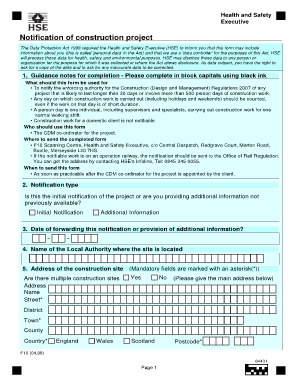
 With the changes to the CDM regulations, back in 2015, I have noticed there seems to be some confusion over the HSE’s requirements for notification. There also appears to be a misunderstanding regarding the link between notification and the need to appoint a Principal Designer and a Principal Contractor.
With the changes to the CDM regulations, back in 2015, I have noticed there seems to be some confusion over the HSE’s requirements for notification. There also appears to be a misunderstanding regarding the link between notification and the need to appoint a Principal Designer and a Principal Contractor.
Clients regularly ask me whether they need to appoint a Principal Designer, and how the HSE defines construction work, working days & person days.
Due to this we have put together an online calculator to help clarify whether notification to the HSE is required.
So what is HSE notification?
Simply put, it is a form, know as the F10, that is sent to the HSE to let them know about proposed construction works. It should be noted that the HSE’s definition of ‘construction work’ is far broader than most think, for further information click here.
Within this form the HSE require certain information to allow them to understand what, when, where and by whom a construction project is being carried out.
Notification under CDM 2007
Under CDM 2007 notification of a project triggered the appointment of a CDM Coordinator and a Principal Contractor; however, CDM 2007 did not apply to Domestic Clients.
This meant that if a project was expected to last more than 30 days or involve more than 500 person days the client either had to make these appointments or discharge the duties themselves.
Under CDM 2007, notification was a duty of the CDM Coordinator, but this has change with the introduction of CDM 2015.
Due to how CDM 2007 was being interpreted, I regularly found myself being appointed at short notice and therefore filing the F10 at the 11th hour.
So what’s change under CDM 2015?
Most importantly, Domestic Clients are now covered under CDM 2015, meaning small developments or extensions for private clients may be notifiable.
The HSE also tinkered with the time threshold for notification. The new threshold is similar to how it was under CDM 2007, with the addition of an important and strategically placed ‘and’.
Under CDM 2015 a project is now notifiable if it ‘lasts longer than 30 days AND has more than 20 workers, working simultaneously at any one point OR exceeds 500 person days’.
Therefore, smaller projects that lasted more than 30 days, thus notifiable under CDM 2007, no longer require notification, provided less than 20 people are working at any one point.
Interestingly, this means that a smaller project, with say a maximum of 4 workers, would not require notification unless the project lasted over 4 months (500days/4persons = 125days).
The duty of notifying the HSE has also been passed to the client, although most Principal Designers will either assist with this or submit the form on their behalf.
Finally, appointment of a Principal Designer & a Principal Contractor is no longer linked to whether a project is notifiable or not. Therefore, it is possible to have a notifiable job that does not require a Principal Designer or a Principal Contractor, and vice versa.
So what does the HSE mean when they refer to days and person days?
A day or ‘working’ day is any day in which construction work is carried out, this applies to both full and part days. If you only plan to carry out work during the afternoon for example, this will still be counted as a working day when calculating whether notification is required. Obviously, weekends also count towards the quota, if any construction work takes place.
Conversely, this also means that if there is a break in a construction project, for a week or two, those days would not be counted when assessing whether notification is required.
I have been asked by several clients to clarify working days when applied to unusual working patterns. ‘What if we started the day at 4pm and worked through the night and finished before 4pm the following day? Surely this would only count as 1 day, as it’s within a 24hr period’.
Unfortunately, the HSE does not make a clear distinction on whether they class a day as a calendar day or a 24 hr period, and in this instance, I would recommend erring on the side of caution and count the above as two days.
A person day is one person working a normal working shift. Some projects have more than one shift per day, for example a morning and an afternoon shift. So in one day, if you have 7 people on the morning shift and 10 people on the afternoon shift, you would have 17 person days.
So what information is needed on the F10 form?
While the information required by the HSE is not taxing, it is possible to misinterpret the information they are asking for. Broadly, the following information is required when filing the F10:
the project address
a brief description of the construction work
the planned duration of the construction phase.
details of the project team including Client, Principal Contractor & Principal Designer (if required), along with any designers and contractors already appointed.
the date planned for project commencement
the time allowed for planning and preparation of the construction work by the principal contractor
details of the maximum number of people, and also the maximum number of contractors that will be at work on the construction site.
It should also be noted that, rightly, the ‘time allowed for planning’ is a key piece of information in the eyes of the HSE. The HSE take a dim view on projects that have a short planning duration, as they feel this impacts on the Principal Contractors ability to properly plan the Health & Safety aspects of a project.
Notification to the HSE should be made as soon as is practicable, but MUST be done before the construction phase begins.



